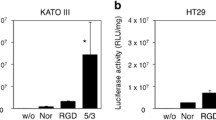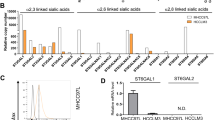Abstract
A human colon cancer cell line, OCUC-LM1(LM), was established from a liver metastasis in our laboratory. Intrasplenic injection of LM into nude mice was repeated three and five times, and the daughter cell lines were designated as LM-H3 and LM-H5 respectively. The level of sialyl Lewis A (SLA) in the supernatant of LM-H3 and LM-H5 was 3 and 4.5 times higher than that of LM respectively. Flow cytometric analysis of SLA expression showed that the peak channel for LM was 113; for LM-H3, 126; and for LM-H5, 146. The mean fluorescence intensity of LM was 102.3 +/- 43.5; for LM-H3, 126.2 +/- 28.4; and for LM-H5, 144.8 +/- 23.4. In endothelial cell adhesion assays, the percentages of adherent LM-H3 and LM-H5 cells were significantly higher than for LM. The activity of alpha1-->4 fucosyltransferase was higher in LM-H3 and LM-H5 than in LM, but there was no difference in alpha2-->3 sialyltransferase activities for type 1 chain among the cell lines. Our results suggest that SLA expression is associated with acquisition of a high capacity for liver metastasis of colon cancer; increased SLA expression is due mainly to increased fucosyltransferase activity.
Similar content being viewed by others
Author information
Authors and Affiliations
Rights and permissions
About this article
Cite this article
Yamada, N., Chung, YS., Takatsuka, S. et al. Increased sialyl Lewis A expression and fucosyltransferase activity with acquisition of a high metastatic capacity in a colon cancer cell line. Br J Cancer 76, 582–587 (1997). https://doi.org/10.1038/bjc.1997.429
Issue Date:
DOI: https://doi.org/10.1038/bjc.1997.429
- Springer Nature Limited
This article is cited by
-
Characterization of N-glycome profile in mouse brain tissue regions by MALDI-TOF/MS
Analytical and Bioanalytical Chemistry (2023)
-
Glycosylation as a regulator of site-specific metastasis
Cancer and Metastasis Reviews (2022)
-
Amigo2-upregulation in Tumour Cells Facilitates Their Attachment to Liver Endothelial Cells Resulting in Liver Metastases
Scientific Reports (2017)
-
Regulation of the metastatic cell phenotype by sialylated glycans
Cancer and Metastasis Reviews (2012)
-
The Potentials of Glycomics in Biomarker Discovery
Clinical Proteomics (2008)




